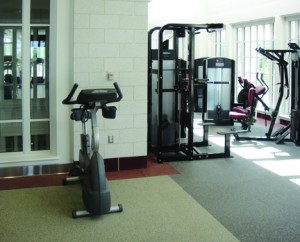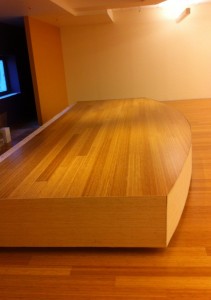Members go to clubs to get healthy, be healthy and stay healthy. Green products aid in this goal by limiting toxins, improving air quality and lessening a club’s impact on the environment for future generations.
No club wants to lose its aesthetic appeal and by choosing green products such as recycled rubber flooring — no one has to choose between “going green” and looking good, saving money or being functional.
Principles for Sustainable Design:
1. Use Low-Impact Materials: Choose non-toxic, sustainably produced or recycled materials which require little energy to produce.
• Through recycled rubber tile manufacturing, one manufacturer has kept over 2 million tires out of landfills since 1998. One tire produces about 10 square feet of rubber flooring.
• When choosing low-emitting materials, many recycled rubber products are FloorScore® certified and CHPS (Collaborative for High Performance Schools) compliant.
2. Energy Efficiency: Use manufacturing processes and produce products which require less energy to maintain.
• Recycled rubber flooring requires less maintenance than other types of flooring. Vacuuming then damp mopping is the preferred method of cleaning, with very little or no detergent necessary.
• No need to resurface or refinish over the life of the product, reducing maintenance costs.
3. Quality and Durability: Longer-lasting and better functioning products will have to be replaced less frequently, reducing the impact of producing replacements.
• Life expectancy in high-traffic areas is far greater than most carpet/tile products. Rubber can withstand rolling load and heavy foot traffic with little or no visible wear.
• Life expectancy of rubber flooring can be up to 20 years in commercial applications depending on type of traffic.
4. Design for Reuse and Recycle: Products, processes and systems should be designed for performance in a commercial “afterlife.”
• Recycling programs at many rubber flooring manufacturing facilities grind old products and post-production waste for use in new products.
• Many types of interlocking rubber tile products can be flipped over, doubling the life of the floor.
For more information contact Cara Murphy, the marketing manager at cmurphy@dinoflex.com, or 1.877.713.1899.
There are a lot of different opinions on what is considered “green” and what is not. That opens the door to a lot of “green washing,” in which one part of a product can be easily seen as green, while another facet of it is not. I look at “green” as any product which uses recycled content and can be recycled at the end of its useful life, or can be made from extremely rapidly renewable materials.
The argument about being “green” has larger societal impacts to it and I think that members appreciate when a club is making strides towards good stewardship of the environment by recycling, buying green products and using alternate forms of energy when possible.
Additionally, the resurgence of more holistic types of activities like yoga and Pilates, which take on a more natural, Eastern philosophy of coexistence, has also contributed to the desire to have harmony with the earth. This has lead to the adoption of green products and practices as well. When clubs show that they also embrace these beliefs, they certainly create a much more welcoming environment for the participants in these extremely popular activities within their club, and are much more likely to attract new patrons to these types of classes.
In recent years, it has been harder to find fitness flooring that isn’t certified as green. Most rubber flooring is made of tiles or rolls of re-ground rubber, most carpeted areas are now using recycled carpet tiles and most hardwood areas are using bamboo or hardwoods that come from mills that are certified as green. In fact, whole standardizing bodies have been set up in order to certify products as green. These products have come to the market, and these certification bodies established because the market has demanded that products become green in a verifiable fashion. As a result, there is little question that club owners have already decided that buying green products is an important element to retention and attracting new members.
The easiest thing that a club can do to become more green, as it applies to flooring, is to use greener cleaning solutions. We recommend that only the very simplest products be used when cleaning the floors that we install, but we recognize that there are types of floors and certain situations that require more aggressive cleaning solutions. In those situations we recommend that the floors be maintained by using products that are also certified as green.
For more information contact Steve Chase, the general manager at sales@fitnessfloors.com or 800.428.5306.









